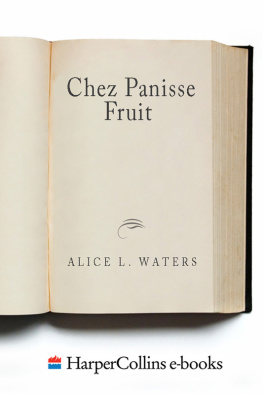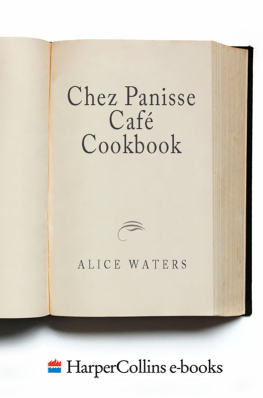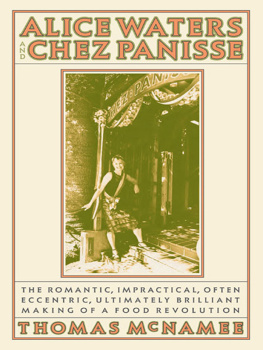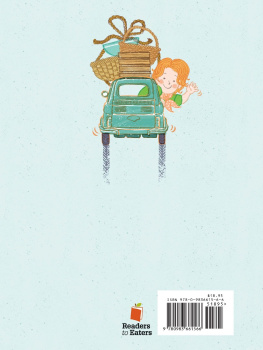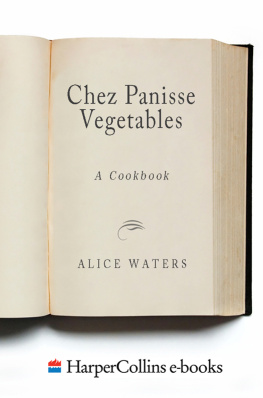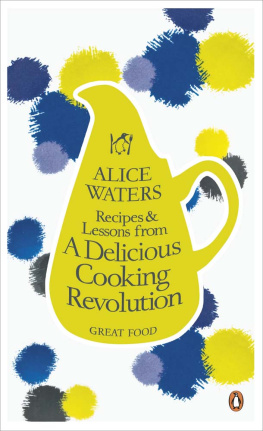CHEZ PANISSE FRUIT . Copyright 2002 by Alice Waters. All rights reserved under International and Pan-American Copyright Conventions. By payment of the required fees, you have been granted the non-exclusive, non-transferable right to access and read the text of this ebook on-screen. No part of this text may be reproduced, transmitted, down-loaded, decompiled, reverse engineered, or stored in or introduced into any information storage and retrieval system, in any form or by any means, whether electronic or mechanical, now known or hereinafter invented, without the express written permission of HarperCollins ebooks.
Waters, Alice.
Chez Panisse fruit / by Alice Waters and the cooks of Chez Panisse in collaboration with
p. cm.
Includes bibliographical references and index.
1. Cookery (Fruit) 2. Chez Panisse. I. Tangren, Alan. II. Streiff, Fritz. III. Title.
TX811. W32 2002
Once more, thanks are due first to the Chez Panisse cooks I asked to help me set recipes down on paper for this volume, especially Kelsie Sue Kerr, now a chef in the restaurant downstairs, and Samantha Greenwood Wood, a former anchor of the dessert kitchen; both of them helped shape the books contents from the beginning. Recipes also came to us from Tracy Bates, Mary Canales, Patricia Curtan, Sarah Egri, Carly Meyer, Jean-Pierre Moull, Charlene Nicholson, Gilbert Pilgram, Tasha Prysi, Jehnee Rains, Charlene Reis, Alan Tangren, David Tanis, and Anthony Tassinelloall present or former Chez Panisse cooks without whose dedication Chez Panisse could not survive. Our gratitude extends to four great contributors from outside the restaurant: Marion Cunningham, Carol Field, Niloufer Ichaporia, and Shirley Sarvis.
The essays about individual fruits are largely the work of my collaborator, Alan Tangren, the pastry chef at Chez Panisse, whose career at the restaurant has taken him from an early beginning in our kitchens to many years as our foragerour procurement officer, so to speak, and as such, the person responsible for forging our relationships with the scores of mostly local growers and suppliers who bring us the beautiful ingredients that, as we boast on our menu, are almost without exception organically grown and sustainably produced. My other collaborator, Fritz Streiff, has once again served as my editorial mouthpiece and mastermind, testing, correcting, writing, and rewriting at every stage of the project.
For their generosity with their expertise, our hearty thanks to Ernie and Chris Bierwagen, Ray Copeland, Darrell Corti, Al Courchesne, Bill Fujimoto, David Karp, C. Todd Kennedy, Andy Sarhanis, Didar Singh, Jonathan and Lucy Tolmach, and Sue at the Racha Caf.
As always, my partner, Lindsey Shere, has been a particular inspiration to me. Pastry chef for twenty-six years, she tested recipes and made suggestions that were especially welcome; and the immense influence of her esthetics and perfectionism on her successors is reflected everywhere in this book. Warm thanks are also owed to the other recipe testers and tasters, among them Thrse Shere, Yoon Ki Chai, Tomas Salis, Nancy Satoda, and numerous other friends and relatives. And I would especially like to thank Cristina Salas-Porras for her invaluable help in coordinating the logistics of the entire project.
Probably most important of all, Chez Panisse Fruit owes the extraordinary beauty and serenity of its illustrations and the clarity and just proportions of its design to Patricia Curtan, who also helped conceive the book almost eight years ago.
Lastly, this book could never have been brought to fruition without the understanding of our editor, Susan Friedland; we thank her again for her enthusiasm, her acumen, and her patience.

This is the eighth Chez Panisse cookbook we have published since the restaurant was founded in 1971, and it begins the same way as all the others: I throw open the window, start to flail my arms, and scream: Pay attention to what youre eating! And then I calm down a little and try to explain why this matters so much to me.
I did not begin to pay attention to food in earnest until I was nineteen years old. I was luckier than most American children who grew up in the 1950s in that I was exposed to at least some foods that were pure, unprocessed, fresh, and seasonal. My parents planted a vegetable garden in our New Jersey backyard where they grew corn, beans, and tomatoes; my sisters and I foraged for wild blueberries in New Hampshire in July; and our suburban town had not yet spilled out of its borders and buried the small orchards and truck farms that surrounded it.
But nothing I ate prepared me for the food of France, where I went for my junior year of college. There, for the first time in my life, I learned that good food could be a serious pleasure and that its pursuit was worthy of the utmost concentration and discrimination. In France people not only gave deep thought to their next meal; they surrendered themselves utterly to its sensual enjoyment.
It was a year of a thousand epiphanies: the bread fresh from the wood-burning oven of my neighborhood bakery; the cheese so unimaginably and ripely various; the staggering bounty of the sea, still glistening and alive at the fishmongers; the long meals with my new French friends, whose passion for food was so grown-up in its refinement and so childlike in its exuberance.
And then there was the fruit. I will never forget those first fraises des bois scattered on the plate. What are these strawberries of the woods, I thought; they look awfully tiny. But when I popped one in my mouth and tasted the concentrated essence of high springtimeso sweet, so spicily indescribablemy eyes fluttered shut and I didnt know what to say. It had never occurred to me that strawberries originally came from the woods nor that I was deeply connected with nature. All at once I had a glimmer of understanding of the truth that Wendell Berry would express so well years later: Eating with the fullest pleasurepleasure, that is, that does not depend on ignoranceis perhaps the profoundest enactment of our connection with the world.
Long after that year in France, I began to plant fraises des bois in the yard of my Berkeley house, and when my daughter was just beginning to walk, I encouraged her to find her way among the strawberry plants and pick the ripe ones. I watched as her eyes, too, fluttered shut when she tasted one. She grew up in the garden picking strawberries and raspberriesand always only the ones that were perfectly ripe. To this day she would rather have a bowl of berries than a piece of chocolate cake.
Fruit, more than any of the other foods we consume, has this power to go right to the heart of our being. Fruit is sweet. Fruit is beautiful to look at and beautiful to smell. Fruit teaches us the meaning of time and eternity: a tree blooms in the spring and bears fruit, and the fruit falls ripe to the ground in the summer, carrying within itself the seeds of a new plant that will winter over and begin the cycle again. Is it any surprise that the knowledge of good and evil came to us from a fruit?

